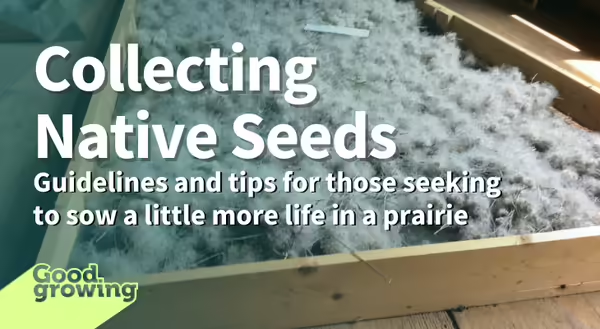
Autumn is a time for…life? This may seem perplexing, as we often link fall with plants dying, wildlife migrating, and us retreating indoors. However, this is when conservationists managing prairies get excited to sow new life.
Managing prairies, forests, or wetlands often involves battling nonnative invasive plants via cutting, pulling, spraying, burning, and any other way you can think to kill a plant. But fall is a great time to introduce life by sowing native seeds. Incorporating new native seeds can boost biodiversity and compete with invasive plants. Each natural space is unique, so the species chosen will vary, but some common practices can help.
Sourcing native seed
Most often wild native plant seeds are used for sowing Illinois prairie. These seeds are harvested from wild plants or from native plant nurseries. Seeds ordered from native seed dealers can be a good option for those just starting their journey into the world of native plants.
Another option is to harvest seeds yourself from existing prairies and natural landscapes. This requires some botanical knowledge to ensure you collect the right species. Seed collection is also a great way to learn plant identification.
Guidelines for Collecting Native Seed:
- Get permission before collecting wild seed on public or private properties.
- Harvest when the seed heads are dry or later in the day when morning dew or frost has evaporated.
- Know which plants you want to collect or have someone with you who can identify them.
- Harvest only a third of the seeds, allowing the rest to naturally reseed.
- Keep species separate and individually labeled. (Or at least keep grasses separate from wildflowers)
- Use a bucket or bag with a shoulder strap to make it easy to carry and stay out of the way while working with your hands.
- Use paper bags to allow excess moisture to wick away.
Selecting Species
Not all native Illinois plants would be well-suited to every location in Illinois. For example, cup plant (Silphium perfoliatum) is a great native species, however, in a small prairie garden, it could become unruly.
Many people think of wildflowers when imagining a prairie, however, a prairie is often comprised of 80 percent grasses and 20 percent wildflowers. Historically, large herbivores such as bison and elk kept grasses in check, but without them, grasses like big bluestem (Andropogon gerardii), switchgrass (Panicum virgatum), or yellow grass (Sorghastrum nutans) can dominate. I recommend avoiding these in small prairies as I have encountered many disappointed prairie gardeners when eventually all they have is a patch of big bluestem and no wildflowers.
But grasses are critical to prairies. For smaller-scale prairies, I typically recommend short-grass prairie species like little bluestem (Schizachyrium scoparium), sideoats grama (Bouteloua curtipendula), the wild ryes (Elymus spp.), and sedges.
Whether you buy them or harvest them yourself, inject life into your natural spaces by sowing native seeds. It will be a nice break from killing invasive plants. Yes, I am avoiding the fact fall is also a good time to control woody invasive species. Today, I am focusing on the fun part of conservation!
Illinois Extension will be hosting a native seed share on Saturday, October 26 at 12:30 pm near Macomb. Please visit go.Illinois.edu/2024SeedShare for more information on the event and to register.
Good Growing Tip of the Week: Many native seeds need to be exposed to cold, wet conditions to germinate. This is called stratification. You can stratify seeds indoors artificially or sow them outdoors in the fall and let the winter do it for you.

Sign up for our emails! Want to get notified when new Good Growing posts are available? SIGN ME UP
Give us feedback! How helpful was this information (click one): Very helpful | Somewhat helpful | Not very helpful
MEET THE AUTHOR
Chris Enroth is a horticulture educator with University of Illinois Extension, serving Henderson, McDonough, Knox, and Warren counties since 2012. Chris provides horticulture programming with an emphasis on the home gardener, landscape maintenance personnel, and commercial landscapers. Additional responsibilities include coordinating local county Master Gardener and Master Naturalist volunteers - providing their training, continuing education, advanced training, seasonal events, and organizing community outreach programs for horticulture and conservation assistance/education. In his spare time, Chris enjoys the outdoors, lounging in the garden among the flowers (weeds to most).